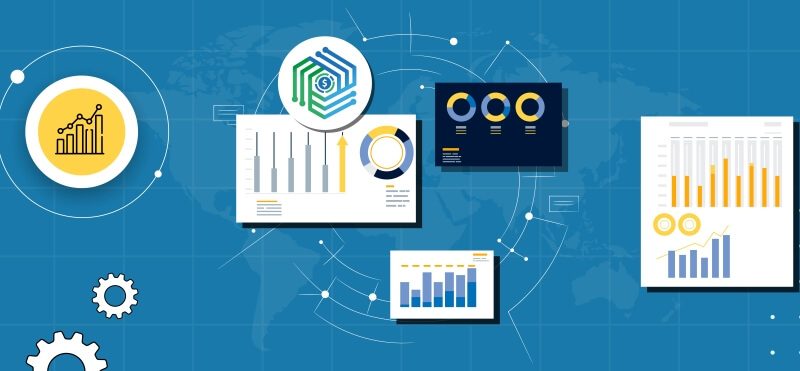The success or failure of any business is often determined by the decision-making process. We’ve all witnessed gigantic companies and multinational corporations fall through, due to a single poor decision, triggering the domino effect and the rest is history, quite literally.
That’s why the main responsibility of an entrepreneur is to ensure that your business decisions are well-informed and contribute to the growth of your company. While there are many factors that feature in a robust decision-making process, none of those is possible without data. This unbiased element of your business is there to guide you, as long as you know how to extract valuable insights from the available pool of information.
And this is where the story of data analytics begins and we’re here to explore it. In this article, we’ll explain what data-driven analytics is and how small and medium business owners can reap the benefits of data analytics tools in making informed business decisions.
In this article we’ll take a closer look at:
1. What is data-driven analytics?
2. Knowledge, experience, and data analytics
3. Asking the right questions in data analysis
4. What are the benefits of data-driven analytics for companies?
5. Do I need a data analyst for my company?
6. How business analytics software can help your company?
What is data-driven analytics?
Data-driven analytics, also referred to as data analysis, is the mechanism through which data from different sources is analyzed to find patterns and trends. This in turn can provide insights and inform business decisions.
Data in its raw form can’t be of much use to companies, since they can’t draw any conclusions from it. Besides, raw data, before it gets analyzed, has to be structured, that is categorized in a meaningful way that allows for analysis. After that, you need to ask the right questions and then perform the right analytics to find the answers. Finally, you can use that information to put those answers into actionable insights.
The result of such analytics can be describing:
- the state of your business (descriptive analytics);
- the source of current issues (diagnostic analytics);
- future trends and patterns (predictive analytics);
- suggested changes (prescriptive analytics).
There are different approaches, programs, and technologies that you can employ to analyze data. In today’s world of analytics, machine learning is for sure a term that has gathered a lot of attention, and for a good reason. Machine learning relates to computer programs that can learn and acquire knowledge through interaction with new information based on prior inputs and algorithms. It’s a branch of computer science and falls into artificial intelligence (AI). Image recognition or self-driven cars are just a few examples of real-world applications of machine learning.
Another important element of analytics is data mining, where a program looks for patterns and useful information while combing through big data (i.e. large pools of data). Customer segmentation, for example, might be a result of data mining analytics.
While these advanced methods can accelerate many companies to achieve great business goals, the question remains: how do you include data technology in the operations of small and medium businesses?
Knowledge, experience, and data analytics
Since data analytics and data science in general has taken over online commerce, there’s been an uproar regarding the dismissal of knowledge and experience in this newfound approach.
Business analytics can be a trusted companion to many companies both big and small, as long as you see it as a tool for examining your performance and growing your company rather than a system that is there to replace the valuable skills your team already has. Analytics can enhance what you already know and help you discover new patterns and trends that can be used to further develop your products or services. Data and subsequent analysis can only add to your knowledge and experience, not subtract from it. Exploring areas like predictive product analysis is crucial in this context, as it enables businesses to forecast the success of new offerings, thereby making more informed strategic decisions.
Learn how to create an effective data dashboard that tells a story.
Asking the right questions in data analysis
Having a lot of data collected can’t tell you much about a business problem you might have since data doesn’t equal answers. What’s more, not all insights are meaningful or useful to your business. For example, knowing that 2% of all of your customers were named Sarah isn’t much of a help to you, but finding out that 80% of your customers are women, is much more valuable information that can help you in creating a more customer-aligned marketing strategy. And here is where knowledge and expertise meet data analytics: your team gets the data so they can now develop a much better strategy as it will be data-informed.
Learn what data aggregation is and how it can help your business.
What are the benefits of data-driven analytics for companies?
As noted above, data analytics allows you to scrutinize the available data to generate actionable insights that’ll help you make important business decisions. It’s not easy to make sense of all the data coming in from multiple sources by simply looking at it with the naked eye. You need to take it through critical analysis using advanced tools and technologies to get practical discernments. Here are the main reasons why your company needs data-driven analytics:
Improved decision-making process
With data analytics, you get an indispensable piece of information. It shows you the actual picture of your company, your customers, or the market at large. Couple that with knowledge and expertise, and you’re on the way to a robust decision-making process that benefits your company.
Reduced risk
Thinking of launching new products or services, or investing in new technology? Data analytics can provide you with sound advice. We can’t say that using prescriptive analytics is going to guarantee success, but it greatly reduces the risk of failure.
Informed growth
Knowing where you want to be in your business journey is essential but without tools to guide you in this process it’s like trying to get there without a map. Data analytics can help you estimate the growth trajectory so that you can optimize your operations accordingly. This can also prepare you for impending difficulties and can give you enough time to safeguard your business.
Increased productivity and efficiency
Data analytics can be easily applied to increase the efficiency of your team and the workflow. You can find bottlenecks and create solutions to them. It can inform you about the internal workings of your company, your teams, and your business processes.
Expanded understanding of the market
There’s actually no understanding of the market and your competitors without using some data analytics. This is simply because you need an enormous amount of data sources (big data) to create an adequate representation, in fact, an approximation of reality. Knowing where your company stands in your industry and what the current economic conditions are is crucial for navigating your business through those ‘waters’.
Improved ideation and innovation
Understanding your customers and their needs is the foundation on which you develop and improve your offerings. And the best way to achieve that is to use data. It can guide you in selecting or creating the right products or developing better features in your services.
Targeted content
After analyzing your data, you’ll understand in advance what your customers need, which will give you an opportunity to come up with targeted marketing strategies. By integrating digital marketing strategies into this approach, you can create content that focuses on specific segments of your user base and approach them with the right product at the right time, increasing the chances of a successful purchase.
Boosted revenue
Last but not least, revenue is the financial measure which encompasses all of the above points. With a data-based decision-making process, you’re both saving costs on potential mistakes and inefficiencies as well as bringing more profits due to increased productivity, operational efficiency, improved sales, and marketing strategies. This all leads up to boosted revenue for your business.
Do I need a data analyst for my company?
Data analytics, as we’ve hopefully managed to show, is crucial for the growth of any business. You might be wondering then, how to best reap the benefits of analytics. While a steep learning curve in data science may not be what you have in mind, employing a data analyst might be.
In fact, many companies do decide to employ a business analyst. There’s no doubt that such a professional will be able to perform the whole cycle of data analytics, from data collection all the way up to finding creative solutions and opportunities for growth.
However, that doesn’t mean that every company that wants to make data-driven decisions and use data analytics needs to invest in a hefty salary for a business analyst. For e-commerce or SaaS companies, having intuitive software that provides you with data insights might be a good alternative.
Learn about data analytics in e-commerce and how to perform marketing data analysis.
How business analytics software can help your company?
Using data analytics software is an actionable alternative to employing a business analyst if your company isn’t prepared to pay hefty professional fees.
When choosing the software, you want to cut down all the complex elements of data analytics that require a specialist to use. In other words, a hands-free approach works best for business owners to avoid mathematical/statistical/analytical data computations on their part. Instead, they can focus only on the output, which should ideally come in the form of actionable insights.
Asking the right questions is at the heart of data analytics. And usually, the questions that companies are eager to answer can be summarized using the following questions: how do my products or services sell and how can I sell more of them? Let’s explore that.
Analytics software in practice
If you have an e-commerce business, you surely need to know the platform fees that each of the marketplaces charges you. And as you probably realize, it’s not always transparent or easy to understand, let alone compare platform fees. Hence, it’s vital to know which platforms contribute to the largest fee amount and compare them to your profits per each platform.
Or maybe you want to find out what your top-performing customers are so that you can send targeted ads only to them, increasing the chances of repeated purchases. With software like Synder Business Insights, you can get reports on many such metrics, including but not limited to top-performing products, least-performing products, top-refunded products, products most purchased together, Customer Lifetime Value (CLV), Cost of Goods Sold (COGS), gross margins, and many more. The software automatically analyzes large amounts of data from multiple sources and gets real-time insights that’ll help you make well-informed decisions on the next cause of action. By booking office hours, or trying the tool during a 15-day free trial, you can get a good understanding of how the software can answer the analytical questions your business needs.
Data-driven analytics: closing thoughts
Data should be at the heart of the business decision process as it provides a host of opportunities that can help avoid costly mistakes and accelerate growth. To become a data-driven company, you need to harness the power of data through the right analytical lens. The choice should fit your business needs and abilities whether you employ a business analyst or lean on analytical software.
Data will not only remain a dominant element of many business decisions but will keep growing in power. As more companies are adopting this model, it’s best to jump at the opportunity and use it to the benefit of your business.

.png)





